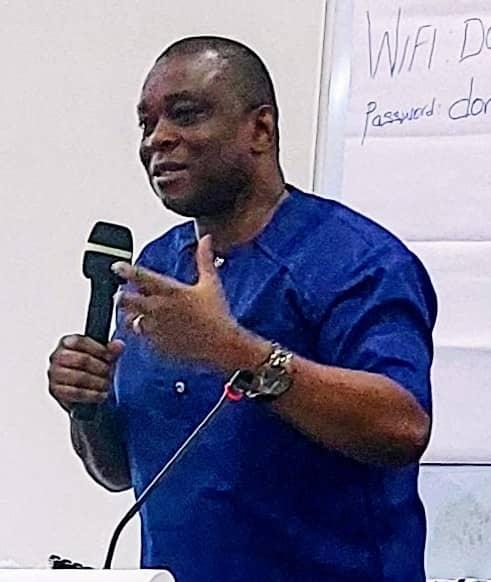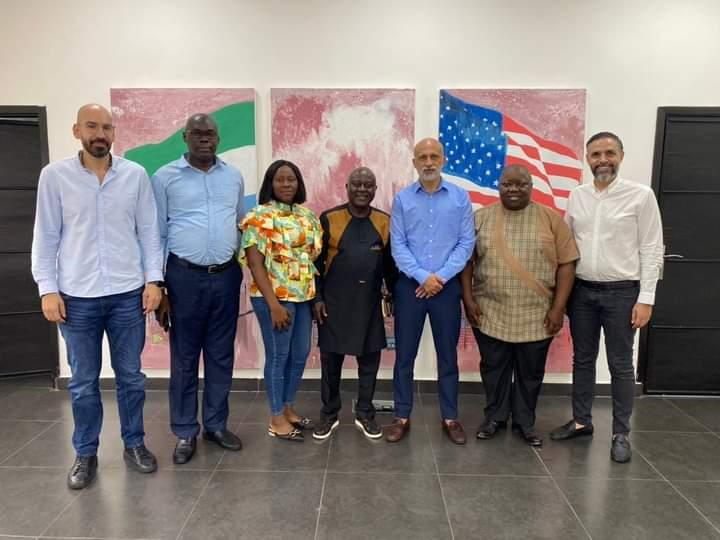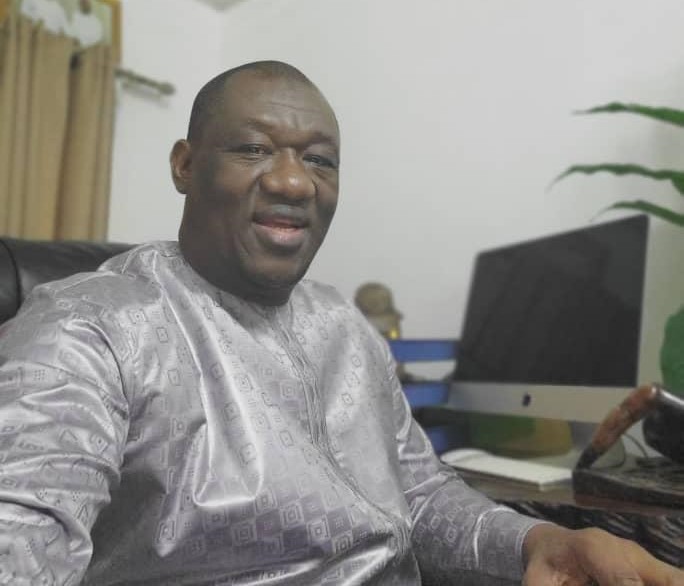Is Sierra Leone’s economy showing signs of economic growth?
“Mr. Speaker, Honourable Members, in concluding this statement, we now do recognize that our people are increasingly concerned and interested in actual outcomes, not promises, not activities and not outputs. The global change in public management means that governments are increasingly being called upon to show results.” These are the famous closing remarks of Sierra Leone’s Minister of Finance and Economic Development, Mr. Samura M.W. Kamara, on the delivery of the budget speech for the FY2011 in the chamber of Parliament on Friday, November 12, 2011. (Photo: Mohamed C Bah, author and presidential aspirant NDA)
I must commend the Minister for his selfless dedication to our nation and his tireless commitment to the people ofSierra Leone. His task of providing the tracks of his government’s economic performance is admirable but yet a daunting challenge. I must, however, disagree with some of the rosy pictures of his budgetary analysis, forecast of growth and the key strategic priorities of “scaling up Infrastructure Investment to Support Higher Economic Growth and widen opportunities for job creation and Income generation.” The budgetary theme is laudable but still falls under the not-too-satisfactory category in so far as tangible results are yet to be seen in full dimension.
ACTION AND RESULTS
Indeed,Sierra Leone’s budget for financial year of 2011 when measured by the three leading indicators of any successful economies: which are growth of the GDP, the rate of inflation and the level of employment qualifies it as a nation on a very long road to recovery.
However, I am in strong accord with the government’s plan of action on robust implementation of stalled projects like the rehabilitation ofNjalaUniversityand theMakeniGovernmentHospital, National Commission for Social Action (NaCSA) projects, the construction of the Bonthe Jetty and the completion of the construction of medical stores nation-wide. Also, the rehabilitation between 5 to 10 kilometers of streets in every district headquarter town, the widening of Wilkinson and Spur Road in Freetown, the construction of a Solar Technicians Training Center in the Port Loko district and the installation of over 200 water stand pipes in Freetown are national development projects that deserve the approval of every citizen of Sierra Leone.
However, Minister Samura missed a golden opportunity in his budget speech to deliver a progress report on these stalled projects or even outlined time tables for completions. A score card on the completion rate will have inspired public confidence and directly increase credibility on his sobering remarks that: “The global change in public management means that governments are increasingly being called upon to show results.”
It was impressive, however, to know that domestic development funds are now being appropriated to finance these ambitious national projects. This is a progressive and radical departure from the so-called 100% donor dependency. And we must continue to scale back on supplementary donor budget and improve on national revenue collections with more focus on tax reforms and export earnings.
REVENUES/EXPENDITURES
On the revenue side,Sierra Leone’s domestic revenue is projected at Le 987.8 billion or 13.0 % of GDP in 2010 compared to 11.6 % in 2009. Actual domestic revenues collected for the first three quarter of the year was Le 703.3 billion compared to Le 551.2 billion in 2009. External budgetary grants are estimated at Le 223.9 including Japanese Food and Oil aid which was Le 40.3 billion and HIPC debt relief which was L19.1 billion.
Expenditure and net lending amounted to Le 1.41 trillion at the end of September 2010 compared to Le 1.5 trillion in 2009. Indeed, a small country likeSierra Leoneshould operate on a balance budget, where its surplus revenues can finance domestic spending, reduce reliance on concessional loans and pay down its national debt. We need to run what is called a “cost-based balance budget.”
DEBT ELIMINATION
Nonetheless, our budget deficit is estimated around Le334.5 billion. Collectively, foreign and domestic financing which amounted to Le 105.3 billion and Le 266.7 billion remains an impediment to government’s fiscal responsibility. This singular problem takes away resources from the education and health budgets that are so critical to national development. IfSierra Leonefocuses on creating debt laws, but does not developed a strategic debt policy of eliminating international debts with the goal of upgrading its credit ratings, we will not be able to produce a robust economy that can create jobs for the next 25 years.
I think the obvious plan to developing a comprehensive Medium Term Debt Management Strategy (MTDS) through International technical assistance may be the road that will lead to a debt-freeSierra Leone. The Common Wealth Secretariat Debt Recording and Management System (CS-DRMS) will better monitor commitments, disbursements and debt service obligations. International investors are looking for competent and transparent governments that are capable of managing their economies with less debt-burden, outstanding credit rating, good business climate and strong investor protection laws.
Comparatively, a developing country likeGhanahas a B credit rating from (Standard and Poor-S&P),Nigeriahas a B+ credit rating also, whileBotswanahas an A2 from (Moody Rating) andMauritiushas a Baa2 rating from (Moody Rating). What is more troubling isSierra Leone’s rapid acceleration of its debt after it completed the Heavy indebt poor countries (HIPC) debt cancellation of $1.6 billion and $600.00 million from the multi–lateral debt relief initiatives (MDRI) in 2006.
Since,Sierra Leonewas left with $100 million; the prudent fiscal approach was to responsibly pay down the debt. NeighboringLiberia, for instance, is a debt free country through the same HIPC and MDRI initiatives with their new national commitment of “NO” to any more international debts. Today, our debt liability stands around $800 million with no concrete plan and national focus to eliminating it.
BUDGET ALLOCATIONS
Furthermore, Minister Samura’s budget speech targeted sustainable goals of improving feeder roads, energy security, clean water, agriculture and food security, health care, educational services and lack of skills in the public sector as “critical priority areas” but the composition of budgetary allocations will not effectively bring the robust progress needed to develop these social sectors. More resources and better trained personnel with a result-oriented goal of meeting serious bench marks seem to be the real solutions to such underfunded sectors.
It seems that total expenditures for 2011 will significantly grow to Le 2.24 trillion or 25.85 % GDP compared to Le 1.86 trillion in 2010. And, total domestic revenues are estimated at Le 1.75 trillion or 20.1 % GDP in 2011. This means,Sierra Leoneis far from performing the cost based balance budget because we are increasing spending more than we are bringing in revenues. We must have a balanced approach in dealing with our national budget.
The allocation of Le 85.7 billion under the domestic development budget for the rehabilitations of streets in district headquarters towns andFreetownwould be considered a bench mark on government commitment to producing “outcome” and “not promises.” The overall budgetary allocation for road sector, including an amount of Le 133.5 billion from donors is estimated at Le 284 billion or 19% of total expenditures. Evidently, investment in key infrastructural projects is a giant step in the right direction.
Another allocation of Le 79.8 billion on energy, Le 6.7 billion to improve access to clean water, Le 4.1 billion to rehabilitate water supply in rural communities and Le 2 billion for the construction of wells are but small and insignificant resources that will not seriously addressed both the aging energy and water crisis inSierra Leone. Massive infusion of trillions ofLeonesinto ‘the energy and water” sectors are necessary to meet adequate public consumptions.
In outlining the list of allocations, the Agriculture Ministry received (Le 22.4 billion), Fisheries and Marine Resources received ( Le 925 million), Ministry of Education received (Le 76.1 billion), Health and Sanitation’s budget (Le 31.9 – non-salary recurrent), Ministry of Social Welfare’s budget (Le 5.8 billion), Military operations budget (Le 56.7 billion), Police budget (Le 32.1 billion), Prisons budget (Le 10.5 billion), Office of National Security’s budget (Le 2.4 billion), Immigration Department’s budget (Le 1.6 billion) and Fire force’s budget (Le 3.6 billion) were all underfunded respectively. The need to apply a cost analysis study on these MDAs is paramount to determining the level of adequate and sustainable funding.
GDP GROWTH
On the GDP growth,Sierra Leone’s economy was estimated to accelerate to 4.5% from 3.2% in 2009. As I indicated earlier the gross domestic product (GDP) of a nation is a good indicator of a growing economy. Compared to 2002 when our GDP growth was 7%, we are still projecting growth at 6% even in 2012. NeighboringLiberia’s GDP growth in 2011 is 9.0% and projection in 2012 will be 12.8%.Gambia’s GDP growth in 2011 is 5.7% and projection for 2012 will be 4.9%.Ghana’s GDP in 2011 is 14.1% and projection in 2012 will be 7.0% whileNigeria’s GDP in 2011 is 7.4% and projection in 2012 will be 5.9% respectively.
This comparative analysis indicates broadly thatSierra Leonemust improve its export recovery from $163 million in 2010 to $365 millions in 2012.That our mineral recovery performance should grow more than 55% in the first quarter of 2012. And agricultural export must exceed the target of generating over $ 200 million annually. Greater effort to reducing our trade deficit of $151 million in 2010 should be challenged with heavy reliance on building the private sector; encouraging Small and Medium Scale Enterprise (SMEs), supporting the manufacturing sector, rolling out attractive tax incentives and exporting more goods than we readily import ( $314 million) annually.
INFLATION & EMPLOYMENT
Another significant indicator of a growing economy is the rate of inflation. That is the sustained increased in the general level of price for goods and services in a producing economy. Accordingly, Minister Samura mentioned that inflation rose sharply in the first half of the year due to the introduction of the Goods and Sales Tax (GST) in January of 2011. The 1% declined of inflation from 17.8% (April) to 16.8% (September) is not a good news to the economy.
This is a worrisome trend since neighboring countries likeLiberiahas 7.2% inflation,Gambiahas 5 %,Ghanahas 8.6% andGuineahas 15.4% in 2011.Sierra Leoneis the only country in the region that has the highest inflation rate. If domestic revenues can be raised by 16.5% of the GDP by 2012, and keeping domestic financing below 2.0% of GDP, and grow the GDP by 9% in 2012, then Sierra Leone will emerge from the slumbers of a troubled economy and begins to produce jobs for millions of its citizens.
On the employment front, Minister Samura, in the budget speech, did not submit any statistical data about the rate of employment or job creating projects as leading indicators of improvement in the 70% unemployment problem. However, the proposed increased in the wage bill from Le 514.9 billion in 2010 to Le 566.5 in 2011 is modest, but on a whole very appropriate. I was particularly impressed with the Account General’s readiness to assign NASSIT social security numbers to civil servants for the purpose of improving on financial record management and preventing waste, fraud and abuse. The benefits of financial record management will strengthen payroll control, predicts retirements, enhance accountability and help in budgetary planning of MDAs in the future.
IMPROVEMENTS/PROGRESS
On the other hand, many Sierra Leoneans believed that the Mines and Mineral Act of 2009 was negotiated in bad faith without looking at relatively other mining agreements from countries likeBotswana,South AfricaandAngola. The 6.5 % royalty rate on all diamond mining activities including artisanal mining will not generate the much anticipated national revenues that will boost economic growth. The corporate tax rate of 30% after the ten year period is contradictory to the normal taxation requirements from global mining companies. Botswanafor example signed a 10 year contract recently with the De Beers on a 45% ownership and the government with a 55% vested interest.
Nonetheless, the government ofSierra Leonehas also made some considerable improvements on the Extension of the Credit Facility by the IMF Executive Board for additional amount of $45.5 million. This ranked Sierra Leone as one of the top performers in macroeconomic management among low income countries (Word Bank Report).The commitment of the Bank of Sierra Leone to create a Credit Reference Bureau that will be fully operational in 2011 will enhance the flow of bank credit to the private sector, identify credit worthy customers and improve lending without risk.
The Private Sector Development Strategy (PSDS) has paid dividend through the supportive role of the Sierra Leone Investment and Export Promotion Agency (SLIEPA) that now rankedSierra Leoneas one of the top four countries for ease of doing business in the Economic Community of West African States (ECOWAS) and the top thirty countries in the world for investment protection.
The passage of the Public-Private Partnership law (PPP) will encourage private sector participation and self-financing of mega-projects in infrastructure like a new international airport, expansion of our natural harbor or the construction of a Lungi-Freetown bridge. Also, the allocation of new resources to establish a commercial dispute court and provincial magistrate court and judicial training center will build transparency and reduce the back- logged in the judicial system.
Investment on Small and Medium Enterprises (SMEs) through venture funds are good plans that will “support higher economic growth and widen opportunities for job creation and income generation.” These are prudent steps with heavy economic implications on the growth of our national economy.
CONCLUSION
Overall, the economy is still taking a baby step to grow but the possibility of a recovery since pre-independent level of a 7% GDP growth appears realistic. To quote Minister Samura again: “the major constrains include inadequate infrastructure, especially roads, electricity, water as well as low level of basic social services.” The outlook ofSierra Leone’s economy is still “uncertain” but promising.
We need to therefore increase infrastructural investments, build an accessible financial sector, accelerate capital financing for SMEs, create disposable income for our citizens and rapidly invest in the public/private sectors as well. Our GDP should grow faster than neighboring countries to 9.4% by 2013 while inflation should drop to a single digit of 4.5% by 2012. And Foreign Direct Investment (FDI) must help to alleviate the unemployment problem.
Indeed, I have faith in the growth of our economy.Sierra Leone’s natural resources and untapped human capital if properly utilized will lift million of people from the bondage of poverty and economic misery. What is needed today is a strategy for change- not the “Agenda for Change” that is still forth coming and slow in delivering the measured results – but a change we can see and believe in. As Minister Samura eloquently puts it: “our people are increasingly concerned and interested in actual outcomes, not promises, not activities, and not outputs.”
by Mohamed C Bah, Presidential Aspirant, NDA
Stay with Sierra Express Media, for your trusted place in news!
© 2011, https:. All rights reserved.





